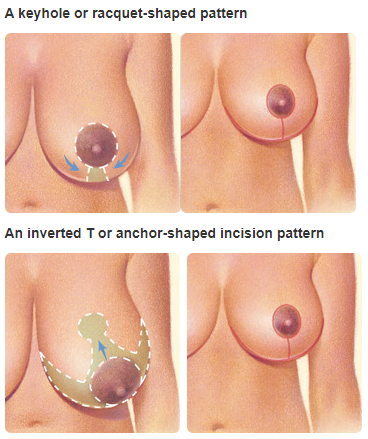Breast Reduction in Memphis
Overly large breasts can cause health and emotional problems. In addition to self image issues, you may also experience physical pain and discomfort. The weight of excess breast tissue can impair your ability to lead an active life. The emotional discomfort and self-consciousness often associated with having large pendulous breasts can be as important an issue as the physical discomfort and pain.
Breast reduction, also known as reduction mammaplasty, is a procedure to remove excess breast fat, glandular tissue, and skin to achieve a breast size in proportion with your body and to alleviate the discomfort associated with overly large breasts.

Breast reduction is a good option for you if you:
- Are physically healthy
- Have realistic expectations
- Don’t smoke
- Are bothered by feeling that your breasts are too large
- Have breasts that limit your physical activity
- Experience back, neck, and shoulder pain caused by the weight of your breasts
- Have shoulder indentations from bra straps
- Have skin irritation beneath the breast crease
Consultation and Preparing for Surgery
- Your surgical goals
- Medical conditions, drug allergies, and medical treatments
- Current medications, vitamins, herbal supplements, alcohol, tobacco, and drug use
- Previous surgeries
- Family history of breast cancer and results of any mammograms or previous biopsies
- Evaluate your general health status and any pre-existing health conditions or risk factors
- Examine your breasts and may take detailed measurements on their size, skin quality, and location of your nipples and areolas
- Take photographs
- Discuss your options
- Recommend a course of treatment
- Discuss likely outcomes of breast reduction and any risks or potential complications
- Discuss the use of anesthesia during your breast reduction
- Get lab testing or a medical evaluation
- Take certain medications or adjust your current medications
- Provide the results of your most recent mammogram, or obtain a new mammogram if you are not up to date with recommended guidelines
- Stop smoking
- Avoid taking aspirin, anti-inflammatory drugs, and herbal supplements as they can increase bleeding
The Procedure

Risks and Safety
The decision to have breast reduction surgery is extremely personal. You will have to decide if the benefits will achieve your goals and if the risks and potential complications are acceptable. Although there is a fair amount of scarring associated with breast reduction surgery, it has one of the highest rates of satisfaction among procedures performed by plastic surgeons. Most women note significant improvement in their neck, back, and shoulder discomfort. They are more able to participate in athletic activities, and their clothing choices are liberalized.
Prior to undergoing breast reduction surgery, you will be asked to sign consent forms to ensure that you fully understand the procedure and any risks and potential complications.
The risks include:
- Allergies to tape, suture materials and glues, blood products, topical preparations, or injectable agents
- Anesthesia risks
- Bleeding
- Blood clots
- Breast asymmetry
- Breast contour and shape irregularities
- Changes in nipple or breast sensation, which may be temporary or permanent
- Deep vein thrombosis, cardiac and pulmonary complications
- Fluid accumulation
- Infection
- Persistent pain
- Poor wound healing
- Possibility of revisional surgery
- Potential inability to breastfeed
- Potential partial or total loss of nipple and areola
- Skin discoloration, and permanent pigmentation changes
- Unfavorable scarring
- Scarring within the breast tissue may cause firmness or lumps know as fat necrosis
These risks and others will be fully discussed prior to your consent. It’s important that you address all of your questions directly with your plastic surgeon.
You should know that:
- Your ability to breastfeed following reduction mammaplasty may be limited; talk to your doctor if you are planning to nurse a baby
- The procedure can be performed at any age, but is best done when your breasts are fully developed
- Changes in the breasts during pregnancy can alter the outcomes of previous breast reduction surgery, as can significant weight fluctuations
Recovery After Surgery
After your breast reduction procedure is completed, dressings or bandages will be applied to the incisions. You’ll need to wear an elastic bandage or support bra to minimize swelling and support your breasts as they heal. A small, thin tube may be temporarily placed under the skin to drain any excess blood or fluid that may collect.
You will be given specific instructions that may include how to care for your breasts following surgery, medications to apply or take orally to aid healing and reduce the potential for infection, specific concerns to look for at the surgical site or in your general health, and when to follow up with your plastic surgeon.
Be sure to ask your plastic surgeon specific questions about what you can expect during your individual recovery period.
- Where will I be taken after my surgery is complete?
- What medication will I be given or prescribed after surgery?
- Will I have dressings/bandages after surgery?
- When will they be removed?
- Are stitches removed? When?
- When can I resume normal activity and exercise?
- When do I return for follow-up care?
When you go home
If you experience shortness of breath, chest pains, or unusual heart beats, seek medical attention immediately. Should any of these complications occur, you may require hospitalization and additional treatment.
Results
The results of your breast reduction surgery are immediately visible. Over time, post-surgical swelling will resolve and incision lines will fade. Satisfaction with your new image should continue to grow as you recover from surgery. The final results of your breast reduction will appear over the next few months as breast shape and position continue to settle. Incision lines are permanent but will continue to fade over time.
The results of your breast reduction surgery will be long-lasting. However, your breasts can continue to change due to aging and gravity. You’ll be able to retain your new look longer if you:
- Maintain your weight
- Keep a healthy lifestyle
Although good results are expected from your procedure, there is no guarantee. In some situations, it may not be possible to achieve optimal results with a single surgical procedure and another surgery may be necessary.
Following your physician’s instructions is essential to the success of your surgery. It’s important that the surgical incisions are not subjected to excessive force, swelling, abrasion, or motion during the time of healing. Your doctor will give you specific instructions on how to care for yourself.
Robert Wallace MD
“Dr. Robert D. Wallace has been recognized for many years as one of the best plastic surgeons in the United States and has an international reputation for his work in craniofacial, cleft, and cosmetic surgery. He has been on Castle Connelly’s Top Doc list and Best Doctors award for many consecutive years. In addition, he was selected by Newsweek magazine in 2021 and 2022 as one of the top 100 plastic surgeons in the USA on their list for facelift and rhinoplasty surgery. In 2022 he was honored by Memphis Business Journal with the Healthcare Hero award in the physician category for his work in pediatric and craniofacial surgery. He has published multiple medical articles and book chapters in plastic surgery literature.”

Get In Touch
If you have any questions or want to schedule an appointment, contact us and our team will be glad to support you